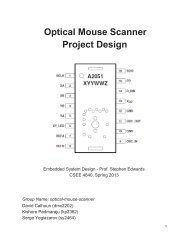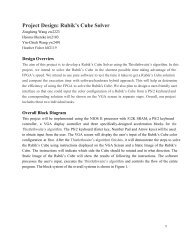Verilog and SystemC - Columbia University
Verilog and SystemC - Columbia University
Verilog and SystemC - Columbia University
Create successful ePaper yourself
Turn your PDF publications into a flip-book with our unique Google optimized e-Paper software.
Related work<br />
Previous work comparing two or more HDLs is<br />
limited to a few papers, usually regarding VHDL<br />
<strong>and</strong> <strong>Verilog</strong>. This is mainly due to the fact that<br />
<strong>SystemC</strong> is a latecomer to this field, but also<br />
because it is merely an extension of an already<br />
existing language.<br />
Douglas Smith wrote a tutorial [5] in which he<br />
compares VHDL <strong>and</strong> <strong>Verilog</strong>. Smith also describes<br />
the range of modeling capacity possessed by the<br />
two languages, exposing VHDL’s lower modeling<br />
limit: gate level. Interestingly enough, <strong>Verilog</strong> is<br />
one of the few HDLs capable of modeling down to<br />
transistor level.<br />
Few additional papers dealing with two or<br />
more HDLs exist, but are generally not meant to<br />
bring forth comparison issues, rather to present<br />
co-design techniques such as Agliada [8].<br />
In his paper on co-simulation of VHDL <strong>and</strong><br />
<strong>SystemC</strong>, Agliada introduces a method to<br />
homogenize the system descriptions in order to<br />
simulate them together. This approach calls for a<br />
VHDL to <strong>SystemC</strong> translator. In describing such a<br />
tool, it is unavoidable to compare the two<br />
languages, even if not in detail.<br />
Fundamental differences in constructs<br />
Both <strong>Verilog</strong> <strong>and</strong> <strong>SystemC</strong> utilize modules as<br />
design entities While <strong>Verilog</strong> has the module<br />
keyword build in, <strong>SystemC</strong> needs to call a<br />
construct named sc_module() to declare the body<br />
of the device at task. The difference in module<br />
declaration syntax can be seen below in figure 1.<br />
<strong>Verilog</strong><br />
module runner(port names);<br />
//port sizes <strong>and</strong> direction<br />
//body<br />
endmodule<br />
Figure 1. Component declaration syntax.<br />
<strong>SystemC</strong><br />
SC_MODULE(Runner) {<br />
//ports sizes <strong>and</strong> direction<br />
//body<br />
};<br />
//member functions<br />
Although <strong>Verilog</strong> may appear slightly more<br />
concise at first, it should be pointed out that the<br />
former requires ports to be listed once in the<br />
module declaration line, <strong>and</strong> again immediately<br />
after, to specify their sizes. <strong>SystemC</strong> accomplishes<br />
this in one step, but at its own can declare a<br />
function separately from its body, as in C. This<br />
property of the language can also be viewed as an<br />
advantage, since a module can therefore call<br />
several different processes. <strong>Verilog</strong> is only able to<br />
carry out a process if found within a module,<br />
which signifies having to write a module for every<br />
process that needs to be called by external<br />
modules. The absence of a high level construct<br />
that replicates structure can often lead into<br />
writing code that may seem repetitive, or difficult<br />
to optimize.<br />
When modeling a process in <strong>Verilog</strong>, common<br />
practice is to have an always construct around the<br />
body of the function to be evaluated. In <strong>SystemC</strong>,<br />
the functions are written as members of the<br />
module class being designed, allowing the designer<br />
to more easily integrate additional functionality in<br />
the same design.<br />
Timing mechanisms vary extensively between<br />
<strong>Verilog</strong> <strong>and</strong> <strong>SystemC</strong>. The later has a built-in<br />
clocking mechanism, where such a device <strong>and</strong> its<br />
output signal wave can be described using the<br />
sc_clock() construct. Instead, <strong>Verilog</strong> uses a more<br />
general way to create a clock: by defining it as a<br />
module. Although this technique may appear<br />
inefficient, it is actually more natural for a<br />
beginning designer, since no new constructs need<br />
to be learned. Figure 2 below, illustrates this<br />
point.<br />
<strong>Verilog</strong><br />
<strong>SystemC</strong><br />
module m555 (clock); sc_clock m555("m555",<br />
output clock;<br />
20, 0.5, 5, true);<br />
reg clock;<br />
initial<br />
#5 clock = 1;<br />
always<br />
#50 clock = ~clock;<br />
endmodule<br />
Figure 2. Clock declaration syntax.<br />
<strong>SystemC</strong> allows for three types of processes to<br />
be utilized in the description of a model: methods,<br />
threads <strong>and</strong> synchronized threads.<br />
According to the <strong>SystemC</strong> User’s Guide [4],<br />
methods execute when changes occur in signals<br />
found in their sensitivity list. Upon termination, a<br />
method returns control to the simulation kernel.<br />
Threads behave similarly as methods, but they<br />
may also be suspended <strong>and</strong> reactivated at the







